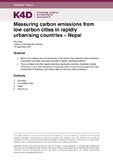| dc.contributor.author | Price, Roz | |
| dc.coverage.spatial | Nepal | en |
| dc.date.accessioned | 2021-12-13T11:16:24Z | |
| dc.date.available | 2021-12-13T11:16:24Z | |
| dc.date.issued | 2021-09-15 | |
| dc.identifier.citation | Price, R.A. (2021). Measuring carbon emissions from low carbon cities in rapidly urbanising countries – Nepal. K4D Helpdesk Report 1045. Institute of Development Studies. DOI: 10.19088/K4D.2021.142 | en |
| dc.identifier.uri | https://opendocs.ids.ac.uk/opendocs/handle/20.500.12413/16999 | |
| dc.description.abstract | Climate change and urbanisation are inextricably linked. With the acceleration of urbanisation in many developing countries, urban areas play a major role in energy consumption and carbon dioxide emissions. This is true of Nepal, which has experienced rapid urbanisation in recent decades. However, no studies were identified that evaluate the efforts of reducing greenhouse gas (GHG) emissions from low carbon cities in rapidly urbanising developing countries. Although, there is literature out there on this that focuses on developed countries and the Global North, this is outside the scope of this report. Given the rapid nature of this review and its limitations it was not possible to fully answer the question of whether investments in low-carbon cities reduce carbon emissions in rapidly urbanising contexts.
The first section of this report looks at the theory of low carbon cities and touches on some of the methodologies for measuring carbon emissions from cities (and the complexities and difficulties with these). The second section looks at Nepal in more detail, highlighting previous literature which has attempted to quantify emissions from cities in Nepal (namely Kathmandu Valley) and the co-benefits of low carbon investment in Nepal. However, overall, literature was largely limited on these topics, and was often older being from 5 years or more ago. Of note is an emissions inventory for Nepal for 2016 by Sadavarte et al. (2019) – although other literature notes that data on emission characteristics are still limited (IMC Worldwide, 2020). ICLEI (2009) also produced city emissions profiles for 3 Nepalese cities, but these are quite outdated. There are several studies related to low carbon development pathways for major cities in developed countries or China, however such studies from the perspective of emerging cities from the developing world are limited. Research into other developing countries with similar characteristics to Nepal was briefly explored in this rapid review but there was not time to fully explore this literature base. Most of the literature explored is from academia, although some is from non-governmental organisations particularly those looking at engaging cities in climate action (such as C40). The literature explored does not look at gender issues or issues of people with disabilities. | en |
| dc.description.sponsorship | FCDO (Foreign, Commonwealth and Development Office) | en |
| dc.language.iso | en | en |
| dc.publisher | Institute of Development Studies | en |
| dc.relation.ispartofseries | K4D Helpdesk Report;1045 | |
| dc.rights.uri | https://www.nationalarchives.gov.uk/doc/open-government-licence/version/3/ | en |
| dc.subject | Climate Change | en |
| dc.subject | Environment | en |
| dc.subject | Health | en |
| dc.title | Measuring Carbon Emissions From Low carbon Cities in Rapidly Urbanising Countries – Nepal | en |
| dc.type | Helpdesk | en |
| dc.rights.holder | © Crown copyright 2021 | en |
| dc.identifier.doi | 10.19088/K4D.2021.142 | |
| dcterms.dateAccepted | 2021-09-15 | |
| rioxxterms.funder | Default funder | en |
| rioxxterms.identifier.project | K4D | en |
| rioxxterms.version | VoR | en |
| rioxxterms.versionofrecord | 10.19088/K4D.2021.142 | en |
| rioxxterms.funder.project | 0986883a-6d0f-4bb8-9c46-5e0682934d65 | en |

